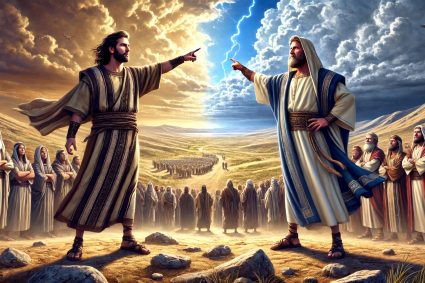


13.3 Light and Darkness
The Path to Truth
Read John 1:4–10; 3:19–21; 5:35; 8:12; 9:5; 11:9–10; and 12:35. What strong contrast is presented here, and why is this contrast fundamental to understanding the truth?
The juxtaposition of light and darkness depicted in the cited Bible passages is a central contrast in the message of the Gospel of John. This contrast is not merely a literary device but a fundamental truth about the spiritual reality of the world and God’s revelation.
The Contrast Between Light and Darkness
-
Light as a Symbol of Truth and Life:
-
Jesus as the “Light of the World”: Jesus is repeatedly described as the “light of the world” (John 8:12; 9:5). In the Bible, light symbolizes divine truth, knowledge, and the eternal life revealed in Jesus Christ. This light guides and illuminates those who turn to God, granting them the ability to live in truth.
-
Life and Light Connection: “In him was life, and that life was the light of all mankind” (John 1:4). This light is inseparably connected to life itself, which can only be found through Christ.
-
-
Darkness as a Symbol of Separation and Rejection:
-
Ignorance and Sin: Darkness represents ignorance, sin, and spiritual separation from God. John 3:19 describes how people reject the light because they love darkness since their deeds are evil. Darkness symbolizes humanity’s natural tendency to turn away from God and remain in sin.
-
Spiritual Blindness: Without the light of Christ, the world remains trapped in spiritual darkness, unable to recognize the truth about God and life.
-
Why Is This Contrast Fundamental?
-
Knowledge of God Is Only Possible Through Light:
-
Inability to Understand God Independently: People cannot recognize or understand God through their own efforts. Darkness highlights humanity’s spiritual helplessness, while light shows that true understanding and life are only possible through the revelation of Jesus Christ. John emphasizes that Jesus alone has made the Father known (John 1:18). Without Him, humans remain blind to divine truth.
-
-
The Choice Between Light and Darkness Determines Our Lives:
-
Decision Point: John 3:19–21 illustrates that everyone faces the decision to seek the light or remain in darkness. This choice has eternal consequences, as light is associated with life in Christ, and darkness with separation and death.
-
Transformation Through Choice: Those who choose the light step out of darkness and are renewed by Christ. This decision is key to true discipleship.
-
-
Light Reveals the Truth About Ourselves:
-
Self-Confrontation: The light of Christ not only reveals the truth about God but also about ourselves. It confronts us with our sins and calls us to repentance (John 12:35–36). Only those willing to step into the light can receive forgiveness, healing, and a new life.
-
Application to Our Lives
-
Shine in the Darkness of the World: As Christians, we are called to reflect the light of Christ in the darkness of this world (Matthew 5:14–16). This means living a life characterized by love, truth, and justice, and inviting those around us into the light.
-
Seek the Truth: We should actively seek the light of Christ by dwelling in His Word, maintaining fellowship with God, and aligning our lives with His standards.
-
Make Decisions in the Light: In our daily lives, we face moral and spiritual decisions. These Bible passages remind us to choose the light as our standard and not the darkness that seeks to deceive us.
Conclusion
The contrast between light and darkness is fundamental to understanding the truth because it describes the spiritual reality of the world. Jesus, the light of the world, reveals God and shows us the path to eternal life. Those who are willing to step into the light will recognize the truth, while those who remain in darkness live separated from God. Our task is to seek the light of Christ, live it, and reflect it in a world that desperately needs guidance and hope.
Read John 8:42–44. How does Jesus describe the false foundation on which the religious leaders of Israel based their faith?
In John 8:42–44, Jesus describes the false foundation upon which the religious leaders of Israel based their faith and reveals a deeper spiritual truth: their self-righteousness and resistance to Jesus stem from a lack of connection to God and deception by the devil.
False Foundation of Faith
-
Self-Deception About Belonging to God:
-
Claiming God’s Children: The religious leaders claim to be children of God because of their lineage from Abraham. However, Jesus exposes that they do not truly love God since they reject Him, the messenger of God (John 8:42). True sonship to God is demonstrated through love for Jesus and acceptance of His message. Their rejection of Jesus shows that they do not stand in God’s truth.
-
-
Dependence on Human Standards:
-
Human-Centric Perspective: Their worldview is shaped by human ideas rather than God’s truth. They interpret the Scriptures and God’s Word through their own perspectives, desires, and pride instead of recognizing the divine truth.
-
-
Influence of the Devil:
-
Devil as Their Father: Jesus clearly states that their true father is the devil (John 8:44). The devil is the father of lies, and they follow his way of thinking by distorting the truth and living in selfishness and rebellion. Their hostility toward Jesus indicates that they do not have God’s truth within them but are under the influence of the devil.
-
Warning for Us Today
-
Danger of Speaking from “Our Own”:
-
Misinterpreting Scripture: When we read the Bible solely from our perspective and according to our needs or desires, we distance ourselves from God’s truth. Just as the religious leaders were blind to the true meaning of God’s Word, we can also misunderstand Scripture if we are not willing to submit to the light of Christ.
-
-
Need for Faith and Obedience:
-
True Understanding Requires Submission: Jesus makes it clear that true knowledge and interpretation of Scripture are only possible through faith and obedience to God. We must consciously submit to God and be willing to give up our own prejudices and desires to recognize the truth.
-
-
Accepting Christ as the Light of the World:
-
Christ Reveals True Meaning: Only Christ is the light that reveals the true meaning of God’s Word. His truth corrects our human perspective and leads us into a genuine relationship with God.
-
Practical Application
-
Self-Reflection: We should regularly examine whether we are reading God’s Word from an egoistic or distorted perspective. Ask God to illuminate our hearts and lead us into the truth.
-
Humility: It requires humility to let go of our own views and be guided by Christ. This applies not only to Bible interpretation but to all aspects of our faith life.
-
Faith and Obedience: True understanding comes through a living relationship with Christ. Trust Him and put His words into practice to grow in truth.
Conclusion
Jesus warns us against interpreting Scripture from “our own” perspective, as the religious leaders did. Their rejection of Jesus and resistance to the truth stemmed from their attachment to lies and pride. True knowledge and understanding of Scripture are only possible through Christ, who is the light of the world. Our task is to open ourselves to the light in faith and obedience, using it as the foundation for our lives and understanding of the truth.
How Do You React to Biblical Teachings That “Kick You in the Feet” – Compared to How You Should React?
When biblical teachings “kick you in the feet,” we often experience an internal conflict. Our natural reaction is not always the one we desire or that is appropriate. Here are typical reactions and the ideal way to handle them:
Typical Reactions to Uncomfortable Biblical Teachings
-
Defensive Attitude:
-
Resistance to Unpleasant Truths: It is easy to resist uncomfortable truths. We might justify ourselves, find reasons why the teaching “does not apply to us,” or ignore the message altogether.
-
-
Minimization:
-
Downplaying the Teaching: Sometimes we tend to downplay the teaching or dismiss it as less important to avoid changing our behavior.
-
-
Frustration or Guilt:
-
Feeling Overwhelmed: Instead of responding constructively, we might feel overwhelmed, condemn ourselves, or believe that we can never meet God’s expectations.
-
How We Should React
-
Humility and Openness:
-
Invitation to Draw Near to God: When a biblical teaching confronts us, it is an invitation from God to come closer to Him. Instead of closing ourselves off, we should humbly acknowledge that God wants to change us through His Word.
-
Scripture Reference: “God opposes the proud but shows favor to the humble” (James 4:6).
-
-
Self-Reflection:
-
Honest Examination: Ask yourself honestly why this teaching affects you. Are there areas in your life that you have not yet surrendered to God? Such questions help identify the root of our resistance.
-
-
Willingness to Change:
-
Openness to Transformation: God does not call us to achieve perfection on our own. Instead, He invites us to open our hearts to Him and allow His Spirit to lead us to change our lives.
-
-
Prayer:
-
Seeking God’s Help: Ask God to help you accept His truth and live according to it. Prayer is a source of strength that provides both understanding and the power to act.
-
Practical Steps
-
Acceptance: Believe that God’s Word corrects us because He loves us and wants our best (2 Timothy 3:16).
-
Study: Dive deeper into the Bible to better understand the teaching and recognize its application.
-
Community: Share your struggles with trusted fellow believers who can encourage and support you.
Conclusion
Our natural reaction to challenging biblical teachings is often defensive or evasive. However, in these moments, God calls us to grow in humility, openness, and obedience. Instead of shutting ourselves off, we should view God’s truth as an opportunity for change and deepening our relationship with Him. Through prayer, self-reflection, and faith that God desires our best, we can learn to live in His light.
The juxtaposition of light and darkness in the Gospel of John is not only a theological concept but also deeply connected to our daily lives and faith. It shows us the reality of our decisions and their impact on our spiritual growth.
-
Light and Darkness in Daily Life
-
Light as Guidance:
-
Moral and Spiritual Clarity: In everyday situations where we must choose between truth and deception, the light of Christ helps us find moral and spiritual clarity to make decisions that align with God’s will. For example, honesty in difficult circumstances requires the courage to live in the light.
-
-
Darkness as Distraction:
-
Temptations and Convenience: Darkness symbolizes temptations and the inclination to do things that may seem convenient but ultimately harm our relationship with God. Everyday scenarios like compromising our integrity or ignoring injustice are examples where darkness entices us.
-
-
Choices Between Light and Darkness
-
Conscious Choice:
-
Daily Priorities: John 3:19-21 reminds us that everyone faces the choice to seek the light or remain in darkness. This choice is reflected in our daily priorities—whether we allocate time for prayer, Bible study, and fellowship with God or let distractions like materialism, selfishness, or pride dominate.
-
-
Consequences of Our Decisions:
-
Impact on Faith Life: Choosing the light leads to a closer connection with God and a fulfilling life, while darkness brings distance from God and inner unrest. Our daily lives are shaped by small decisions that either strengthen or weaken our faith.
-
-
The Light of Christ as a Guide
-
In Relationships:
-
Reflecting Christ’s Light: In our interactions with others, we should reflect the light of Christ through love, forgiveness, and justice. For instance, remaining patient and understanding in conflicts instead of succumbing to anger or bitterness exemplifies living in the light.
-
-
In Work and Society:
-
Christian Testimony: Bearing Christian witness in the workplace involves making ethical decisions, even when unpopular, and standing up for what is right, even when it is difficult.
-
-
Practical Applications
-
Reflect the Light:
-
Matthew 5:14-16: We are called to be the light of the world through our words, actions, and the way we serve others.
-
-
Daily Pursuit of the Light:
-
Engaging with Scripture and Prayer: Seeking the light involves studying the Scriptures, seeking God’s guidance in prayer, and intentionally aligning our lives with His principles.
-
-
Trusting in Christ:
-
Guidance in Darkness: When we find ourselves in darkness or facing challenges, we can trust that Jesus is our light and will show us the way (John 8:12).
-
Conclusion
The contrast between light and darkness is deeply woven into our daily lives and faith. It calls us to consciously choose the light of Christ to find guidance, truth, and life. By seeking the light and reflecting it in the world, we not only live in harmony with God’s will but also offer others hope and a model that can lead them closer to Christ.
Choose Today to Consciously Embrace the Light of Christ, Bringing Truth, Life, and Guidance into Every Darkness.
(Visited 34 times, 1 visits today)























